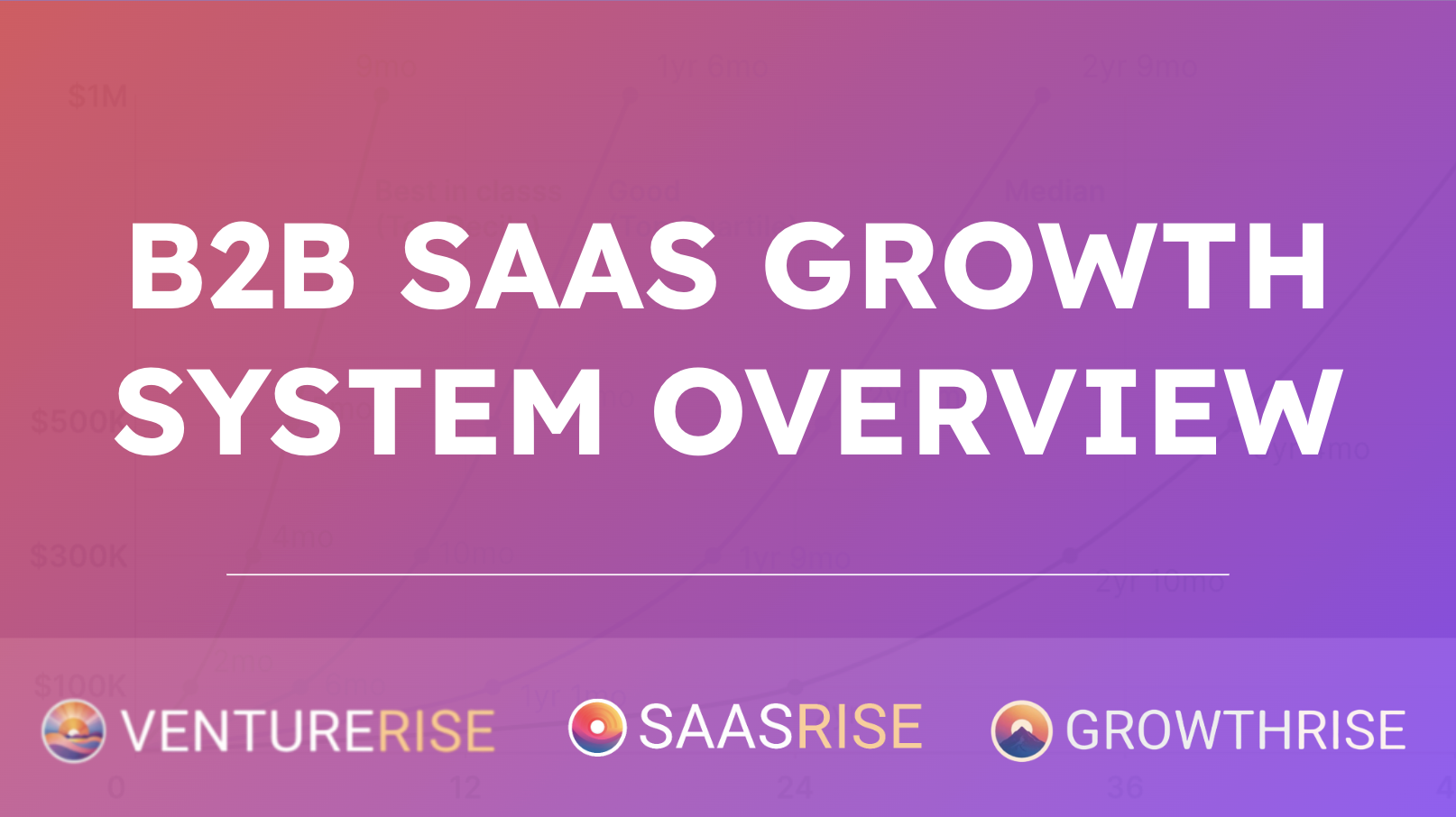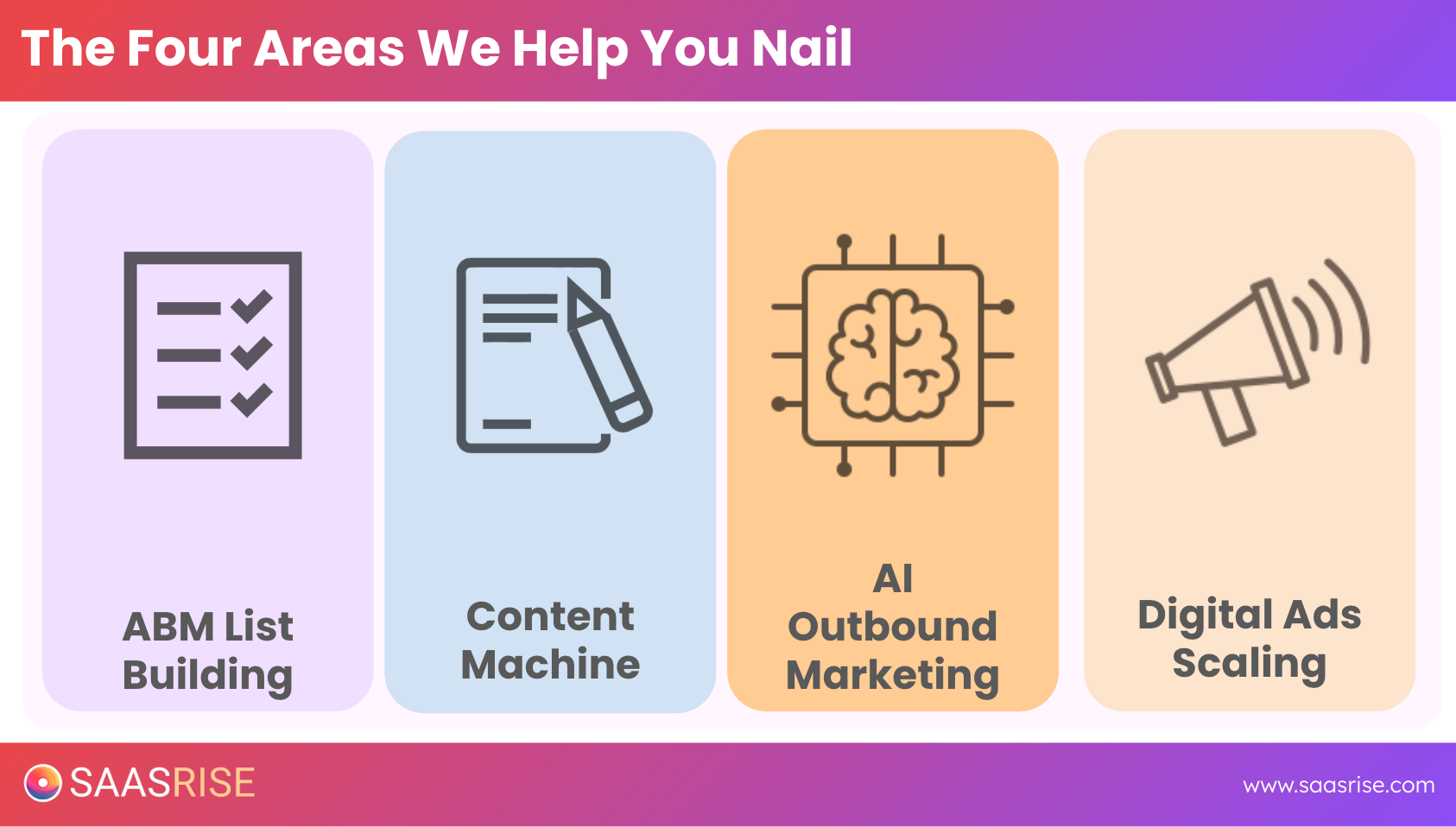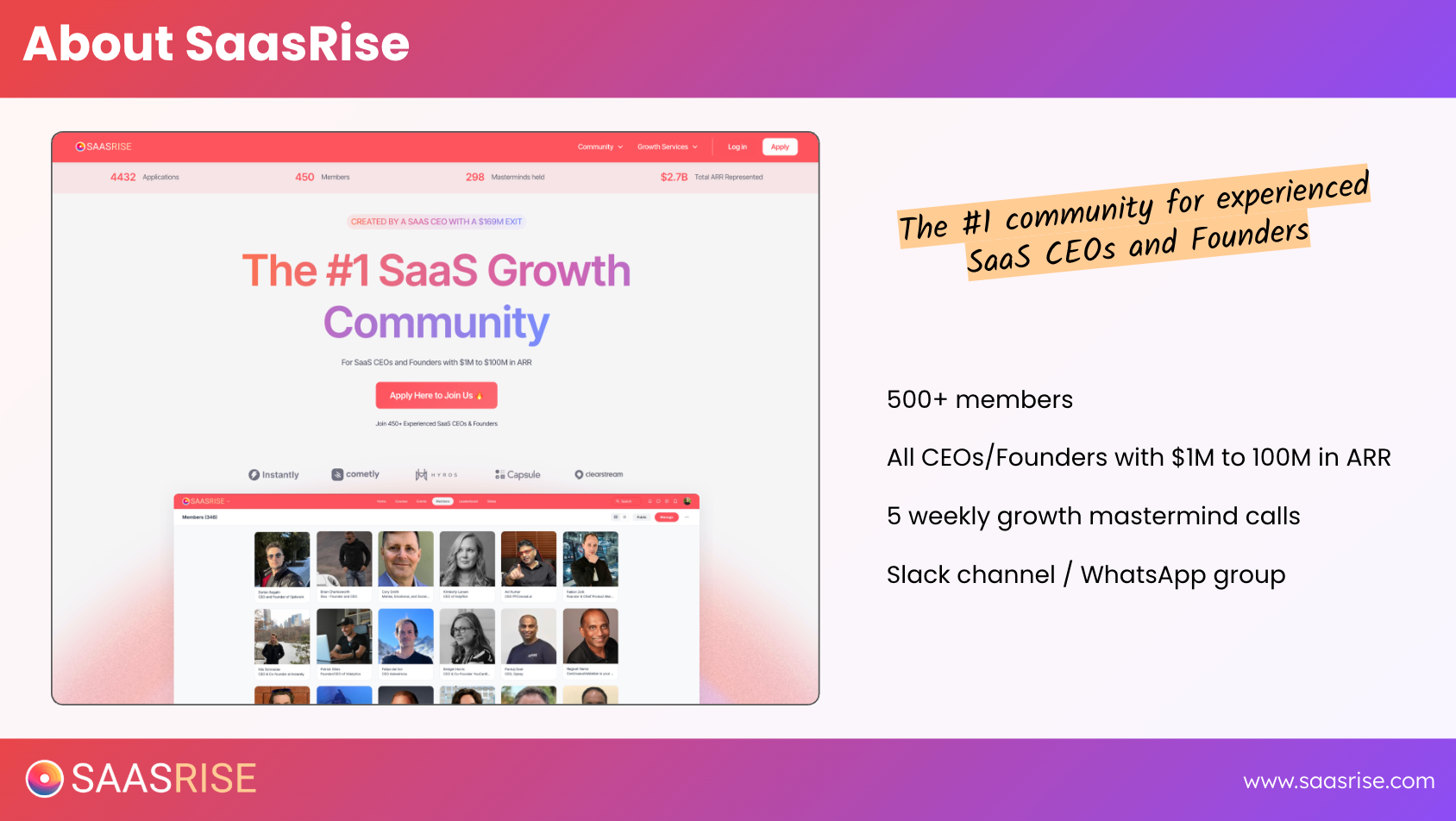
The B2B SaaS Growth System: How to Build Scalable Revenue Engines That Actually Work
Most SaaS founders hit a wall when ads get expensive and outbound stops working. The B2B SaaS Growth Program helps you build predictable growth engines by mastering your numbers, using AI-personalized outbound, and running data-driven ad experiments. It’s not about hacks — it’s about building scalable systems where growth becomes consistent, measurable, and repeatable.
If you’ve ever tried to scale your SaaS company and felt like your growth was hitting a ceiling, you’re not alone. Most founders reach a point where they’ve built something real — they’ve got customers, product-market fit, and a small team — but growth starts to slow.
You try ads. They’re too expensive.
You try outbound. It feels spammy or hard to scale.
You hire an agency or two. Nothing really sticks.
After 23 years building, scaling, and advising SaaS companies — from my first startup iContact (which grew to $50 million ARR and 70,000 paying customers) to running growth programs for hundreds of founders — I’ve realized that scalable growth comes from systems, not tactics.
That’s what I teach in the B2B SaaS Growth Program: how to build two repeatable growth engines — outbound prospecting and digital ads — that can double or triple your qualified lead flow while keeping your CAC in check.
This content is from the 16 week B2B SaaS Growth Program that we run twice a year.

This post breaks down the frameworks and lessons I share in that program — from SaaS unit economics to ABM list building to AI-powered outbound. It’s the playbook we’ve used to help companies like Instantly, Clearstream, and RxNT scale faster and more profitably.
Let’s dig in.
Why Most B2B SaaS Growth Strategies Fail
There’s a reason so many B2B SaaS CEOs say, “We tried ads — they were too expensive,” or “We tried outbound — it didn’t work.”
It’s not because these channels don’t work. It’s because they’re often built on fragmented thinking.
Founders test random tactics without building the underlying systems — the unit economics, targeting, and messaging — that make those channels scale.
What you need instead is a connected growth system:
- Clear unit economics — so you know what a lead and a customer should cost.
- A high-quality ABM list — so you’re targeting the right people.
- AI-personalized outbound and omnipresent ads — so your brand is everywhere your buyers are.
- A feedback loop — so you scale what works and fix what doesn’t.
This is how you move from “random acts of marketing” to a predictable, scalable growth machine.
Understanding SaaS Unit Economics
Before you spend a dollar on ads or outbound, you have to know your unit economics.
Your unit economics are the financial DNA of your SaaS business — they tell you exactly how much you can afford to spend to acquire a customer.
Here are the key metrics you need to calculate:
- ARPA (Average Revenue Per Account) — how much the average customer pays you per month.
- ACV (Annual Contract Value) — ARPA × 12.
- Churn Rate — what percentage of customers leave each month.
- Lifespan — 1 ÷ monthly churn.
- LTV (Lifetime Value) — ARPA × lifespan.
- CAC (Customer Acquisition Cost) — total sales & marketing spend ÷ new customers acquired.
- Payback Period — how many months of revenue it takes to earn back your CAC.
For most SaaS businesses, your goal should be a payback period under 9 months and an LTV:CAC ratio between 6:1 and 8:1.
If you don’t know these numbers, you’re flying blind. Once you do, everything else — targeting, ad budgets, and outbound volume — becomes clear.
Building a Targeted ABM List That Converts
Once your unit economics are dialed in, it’s time to define who you’re going after — and build your ABM list.
ABM (Account-Based Marketing) is about focusing on the right accounts, not just any leads. It’s ideal for companies with an ACV above $1,000/year, and especially powerful when your customers pay $10K–$100K+ per year.
Here’s the process we follow:
- Define your ICP (Ideal Client Persona): job title, company size, location, tech stack, and industry.
- Build your TAM (Total Addressable Market): how many potential accounts fit that ICP.
- Create your ABM list: use tools like Apollo.io, LinkedIn Sales Navigator, ListKit, Clay, or Instantly to gather verified data.
- Enrich and segment your data: categorize by deal size, industry, and buyer type so your messaging stays relevant.
Your ABM list should be large enough to move the needle. For example:
- If your ACV is $2K/year, aim for 300K–400K targets.
- If your ACV is $50K/year, you can succeed with 10K–20K highly qualified targets.
Don’t overthink perfection here — focus on accuracy and depth. A great ABM list becomes the backbone of everything else you do: outbound, ads, and content distribution.
Using AI to Personalize Your Outbound
Cold outbound isn’t dead — bad outbound is.
The magic happens when you combine targeted data with AI personalization to send high-quality messages that feel human.
In our latest cohort, companies saw click-through rates jump from 2% to 10% after adding AI personalization to their outbound campaigns.
Here’s how to do it right:
- Use AI tools like Clay or Instantly’s SmartSearch to generate personalized first lines and contextual references for each prospect.
- Segment your ABM list so that your messages align with industry or role-specific pain points.
- Test 2–3 value-based offers — for example, a free benchmark report, a strategy session, or a relevant case study.
- Track opens, clicks, and replies to identify which messages convert to calls and pipeline.
Outbound works when it’s personal, valuable, and consistent. Pair it with paid ads, and you’ll see compounding returns — your prospects start seeing your name everywhere, which builds trust faster.

Scaling Digital Ads the Smart Way
Here’s a truth most agencies won’t tell you: the goal isn’t to “get ads to work” — it’s to get them to scale profitably.
That means using data-driven experimentation to find what channels, audiences, and creatives drive the best CPL (Cost Per Lead) and CAC (Customer Acquisition Cost).
The five core ad types I recommend for B2B SaaS:
- Retargeting Ads — show up everywhere to people who’ve visited your site.
- Lookalike Ads — find people who resemble your best customers.
- Matched Audience Ads — upload your ABM list and target those exact prospects.
- Paid Search Ads — capture high-intent buyers actively searching.
- Thought Leader Ads — boost your founder or company posts on LinkedIn to build credibility.
We manage over $500K/month in digital ad spend for B2B SaaS companies, and these five types consistently deliver the best results.

The key is structured experimentation. In the B2B SaaS Growth Program, we run about 25 ad experiments in four months — across channels like Meta, LinkedIn, Google, Bing, AdRoll, and G2. By tracking every click, view, and conversion, you’ll know exactly which channels deserve more budget.
Building a Content Machine That Fuels Your Growth
Paid channels can drive demand, but content creates compounding authority.
Every SaaS company should have a content machine — a repeatable system for creating and distributing content that supports your ads, emails, and outbound.
Here’s what that looks like:
- Weekly educational content: insights, benchmarks, or customer stories that teach your audience something valuable.
- Repurpose across channels: take one core piece and adapt it into a LinkedIn post, a short video, and a newsletter.
- Use data from your ABM and ad experiments to fuel your topics — speak to what your audience actually engages with.
When done right, your content keeps you top of mind between outbound touches and ad impressions.
Implementation: Turning the Playbook Into Reality
A strategy is only as good as its execution. That’s why I tell every founder in our program: “Pick an implementer.”
Whether it’s you, your head of growth, or a dedicated marketing manager, someone has to own the weekly implementation work — about 2–5 hours per week.
Here’s how we structure it:
- Weekly Live Sessions (Curriculum): one hour of focused learning each Thursday.
- Office Hours: open Q&A and screen-sharing sessions to troubleshoot challenges.
- Slack + WhatsApp Support: fast feedback during implementation.
Most of our cohorts run 16 weeks. By the end, you’ll have both growth engines (ads and outbound) fully operational — not as theory, but live systems producing leads every week.
And because we cap cohorts around 20–25 companies, you get personalized guidance from me and my cofounder David Troxell, who manages over half a million in monthly ad spend for B2B SaaS clients.
Measuring What Matters: Attribution and Payback
As your system starts producing leads, you’ll need to get serious about attribution — understanding which campaigns actually drive pipeline.
We help companies implement tools like Cometly or Primer to track performance across platforms. The goal is to know your post-view and post-click conversions per channel, so you can scale what’s working and pause what’s not.
Once your attribution setup is solid, you’ll make better decisions — not based on vanity metrics, but based on CAC, payback period, and LTV.
That’s how you scale with confidence.
The Power of Community and Shared Learning
Scaling a SaaS business is hard — but it’s easier when you’re not doing it alone.
That’s why we built SaasRise and GrowthRise — two communities for SaaS CEOs and marketers.


SaaS Rise is for founders and CEOs scaling revenue and preparing for exits. Growth Rise is for B2B marketers driving campaigns day-to-day. Between the two, we now have over 550 members across 20+ countries, sharing playbooks, benchmarks, and lessons in real time.
When you’re surrounded by people who are also running experiments, building ABM systems, and optimizing CAC, your learning curve accelerates dramatically.
Lessons from iContact and Building Again
People often ask why I teach instead of just starting another SaaS company. The truth is — I’ve done that journey.
I started iContact as a 17-year-old college freshman. We built it to $50 million in ARR and sold it in 2012 with 275 employees. After that, I realized what I loved most wasn’t just building companies — it was helping other founders do it better, faster, and smarter.
So now, through SaaS Rise, I get to combine everything I’ve learned — from analytics to creativity, from startup chaos to exit strategy — and pass it on.
The Human Side of Scaling
One thing I always remind founders: you’re building a company, but you’re also building a life.
When I ran this most recent cohort, my wife was five months pregnant with our second son. Our due date — September 7th — is also our wedding anniversary. It’s a reminder that building businesses is part of a bigger story.
You’ll have weeks when things break, when ads flop, or outbound replies dry up. That’s normal. The founders who win are the ones who keep showing up, improving the system a little bit every week.
That’s the beauty of a system — it compounds.
Final Thoughts: Play the Long Game
If you remember nothing else from this post, remember this:
Growth isn’t magic. It’s math + momentum.
Once you know your numbers, build your list, and create consistent outbound and ad systems, your SaaS growth becomes predictable — and scalable.
You won’t need to rely on luck, hype, or another “viral campaign.” You’ll have engines that work 24/7 to bring in qualified leads and customers at a cost you can afford.
That’s what the B2B SaaS Growth System is all about — giving you the clarity, tools, and support to scale revenue with confidence.
If you’re ready to implement it in your own business, join us for the next cohort. But even if you just start by mapping your unit economics and defining your ICP this week — you’ll already be ahead of 90% of SaaS companies out there.
Keep going. Build the system. And let’s grow your SaaS together.
This is from the 16 week B2B SaaS Growth Program that we run twice a year.

